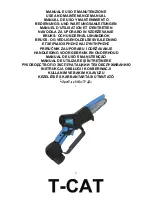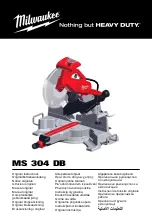
-4-
- KEEP WORK AREA CLEAN.
Cluttered areas and benches invite accidents. Make sure the floor is clean and not slippery due to wax and sawdust
build-up.
- AVOID DANGEROUS ENVIRONMENT.
Don’t use power tools in damp or wet locations or expose them to rain. Keep work area well lit and provide adequate
surrounding work space.
- KEEP CHILDREN AWAY.
All visitors should be kept a safe distance from work area.
- MAKE WORKSHOP CHILD-PROOF.
with padlocks, master switches or by removing starter keys.
- USE PROPER SPEED.
A tool will do a better and safer job when operated at the proper speed.
- USE RIGHT TOOL.
Don’t force the tool or the attachment to do a job for which it was not designed.
- WEAR PROPER APPAREL.
Do not wear loose clothing, gloves, neckties or jewelry (rings, watch) because they could get caught in moving parts.
Non-slip footwear is recommended. Wear protective hair covering to contain long hair. Roll up long sleeves above the
elbows.
- ALWAYS WEAR SAFETY GLASSES.
Always wear safety glasses (ANSI Z87.1). Everyday eye-glasses only have impact resistant lenses, thet are NOT safety
glasses. Also use a face or dust mask if cutting operation is dusty.
- DON’T OVERREACH.
Keep proper footing and balance at all times.
- MAINTAIN TOOL WITH CARE.
Keep tools sharp and clean for best and safest performance. Follow instructions for lubricating and changing
accessories.
- DISCONNECT TOOLS.
Before servicing, when changing accessories or attachments.
- AVOID ACCIDENTAL STARTING.
Make sure the swich is in the ‘’OFF’’ position before plugging in.
- USE RECOMMENDED ACCESSORIES.
Consult the manual for recommended accessories. Follow the instructions that accompany the accessories. The use of
improper accessories may cause hazards.
- NEVER STAND ON TOOL.
Serious injury could occur if the tool tips over. Do not store materials such that it is necessary to stand on the tool to
reach them.
- CHECK DAMAGED PARTS.
Before further use of the tool, a guard or other parts that are damaged should be carefully checked to ensure that
they will operate properly and perform their intended function. Check for alignment of moving parts, breakage of parts,
mounting, and any other conditions that may affect its operation. A guard or other parts that are damaged should be
properly repaired or replaced.
- NEVER LEAVE MACHINE RUNNING UNATTENDED.
Turn power ‘’OFF’’. Don’t leave any tool running until it comes to a complete stop.
- Adjust the upper guide to just clear workpiece.
- Make sure that the blade is properly adjusted and tensioned before operating.
- Do not remove small jammed pieces until the blade has completely stopped.
- Hold workpiece firmly against the table. Do not saw a workpiece which does not have a flat surface unless it can be
supported.
- Turn the machine off if the workpiece is to be backed out of an uncompleted cut.
- To reduce the risk of injury from accidental starting, turn the switch off, unplug the bandsaw and remove the switch key
before changing the set-up, removing covers, guards or the blade.
- Check the alignment of moving parts, binding of moving parts, breakage of parts, bandsaw stability and any other
conditions that may affect the way the bandsaw works.
- If any part is missing, bent or broken in any way, or if any electrical parts do not work properly, turn the bandsaw off
and unplug the saw. Replace damaged or missing parts before using the bandsaw again.
- Choose the right blade size, style and cutting speed for the material and the type of cutting you plan to do.
- Make sure the blade teeth point downward, towards the table.
- Make sure the blade guides and thrust bearings are properly adjusted.
- Make sure the blade tension is properly adjusted.
- To reduce the risk of accidental blade contact, minimize blade breakage and provide maximum blade support, always
adjust the upper blade guide and blade guard to just clear the workpiece.
- Caution: Never cut metals with this bandsaw, only wood and wood products. Use extra caution with large, very small
or awkward workpieces.
































